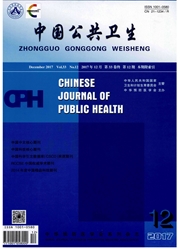

 中文摘要:
中文摘要:
目的:探讨产志贺毒素大肠埃希菌中国分离株携带第1类整合子的特征及所含基因盒的种类。方法:采用纸片扩散法对8株产志贺毒素大肠埃希菌中国分离株进行抗生素耐药性监测;制备细菌转接合子,采用PCR技术鉴定第1类整合子,并对PCR产物测序及结果分析。结果:4株产志贺毒素大肠埃希菌对复合磺胺、四环素、氨苄西林、环丙沙星表现多重耐药,其中2株同时对链霉素和壮观霉素耐药。PCR检测第1类整合子1000 bp 2株,PCR产物测序1000 bp整合子携带腺苷酰基转移酶(aadA1)基因盒并存在于7800 bp可接合质粒上,与sul 1和qacEΔ1基因连锁,分别传递着对链霉素、壮观霉素、复合磺胺和季胺盐类消毒剂的耐药性。结论:产志贺毒素大肠埃希菌中国分离株可接合质粒上第1类整合子携带的aadA1耐药基因盒是该菌株对氨基糖苷类抗生素耐药产生和扩散的重要原因。
 英文摘要:
英文摘要:
Objective To explore the distribution and characteristic of class 1 integrons among Shiga toxin-producing E. coli (STEC) in China, and to elucidate the type of cassettes. Methods Antibiotics susceptibility was tested by the disk diffusion method, class 1 integron was detected by PCR assay and PCR products were sequenced and analyzed in eight isolates. Results Four isolates were multiple-drug resistant whose antibiogram were ampicillin, tetracycline, erythromycin, sulfamethoxazole/trimethoprim and ciprofloxacin, but two isolates conferred resistance of streptomycin and spectinomycin simultaneously. Only the two isolates carried class 1 integrons ranging in 1 000 bpwhich located on the plasmid of 7 800 bp. The sequenced PCR product demonstrated that the 1 000 bp integron harbored aad A1 gene cassettes conferred the resistance of streptomycin and spectinomycin; and linked with sul 1 and qacE△1 gene conferred the resistance of sulfamethoxazole and quaternary disinfectants. Conclusion The class 1 integrons exists among STEC isolates in China and determines the resistant antibiotics.
 同期刊论文项目
同期刊论文项目
 同项目期刊论文
同项目期刊论文
 期刊信息
期刊信息
